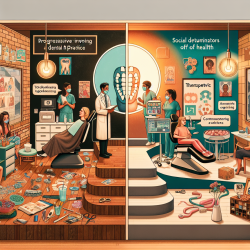Introduction
As practitioners dedicated to improving outcomes for children, we often find ourselves at the intersection of cutting-edge research and practical application. One such groundbreaking study, "A Prospective Study of Environmental Exposures and Early Biomarkers in Autism Spectrum Disorder," also known as the MARBLES study, offers invaluable insights into how environmental factors might influence the development of Autism Spectrum Disorder (ASD). This blog post will delve into the study's findings and discuss how practitioners can leverage this knowledge to enhance their practice.
The MARBLES Study: A Brief Overview
The MARBLES (Markers of Autism Risk in Babies—Learning Early Signs) study is a prospective investigation that examines the role of environmental exposures during pregnancy and early childhood in the development of ASD. Initiated by the University of California Davis, the study has enrolled 463 pregnant mothers, with data collection extending from pregnancy through the child's third birthday. The study's primary aim is to identify environmental agents that contribute to ASD and to uncover early biomarkers of elevated risk.
Key Findings and Implications
The MARBLES study has provided several critical insights:
- Among children evaluated at 36 months, 24% met the criteria for ASD, with another 25% showing non-typical development.
- The study emphasizes the significance of prenatal and early-life exposures, such as pesticides and air pollution, in influencing ASD risk.
- Maternal nutrition, including folic acid intake, has been identified as a protective factor against ASD.
These findings underscore the importance of early intervention and monitoring of environmental exposures, particularly for families with a history of ASD.
Practical Applications for Practitioners
Practitioners can enhance their practice by integrating the MARBLES study's insights into their work:
- Environmental Assessment: Encourage families to be mindful of environmental exposures during pregnancy and early childhood. This includes minimizing pesticide use and ensuring good air quality.
- Nutritional Guidance: Advise expectant mothers on the benefits of folic acid and a balanced diet to potentially reduce ASD risk.
- Early Monitoring: For families with a history of ASD, consider early developmental screenings and assessments to identify atypical development as soon as possible.
Encouraging Further Research
While the MARBLES study provides a wealth of information, it also opens the door for further research. Practitioners are encouraged to stay informed about ongoing studies and consider participating in research initiatives that explore the complex interactions between genetics, environment, and neurodevelopmental outcomes.
Conclusion
The MARBLES study is a testament to the power of research in shaping our understanding of ASD. By applying its findings, practitioners can make informed, data-driven decisions that enhance the developmental trajectories of children at risk for ASD. For those interested in delving deeper into the study, the original research paper can be accessed here.










